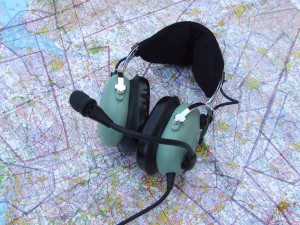
An aircraft call sign is a group of alphanumeric characters used to identify an aircraft in air-ground communications.
Three different types of aircraft call sign may be encountered:
- Type (a) The characters corresponding to the registration marking of the aircraft (e.g. ABCDE). The name of the aircraft manufacturer or model may be used as a prefix (e.g. Airbus ABCDE);
- Type (b) The telephony designator of the aircraft operating agency, followed by the last four characters of the registration marking of the aircraft (e.g. Rushair BCDE);
- Type (c) The telephony designator of the aircraft operating agency, followed by the flight identification (e.g. Rushair 1234).
Flight identification may be the 'public' flight number used for ticketing and aircraft handling or it may be an alternative unique alphanumeric string.
Also, the "telephony designator of the aircraft operating agency" will, in airline use, be the designator of the company for whom the flight is being operated, which may not be the operator of the aircraft.
The full call sign must be used when establishing communications. After satisfactory communication has been established, abbreviated call signs may be used provided that no confusion is likely to arise; however, an aircraft must use its full call sign until the abbreviated call sign has been used in response by the ground station.
Call signs may be abbreviated only in the manner shown below (see table above.)
- Type (a) The first character of the registration and at least the last two characters of the full call sign (the name of the aircraft manufacturer or model may be used in place of the first character);
- Type (b) The telephony designator of the aircraft operating agency, followed by at least the last two characters of the call sign;
- Type (c) No abbreviated form.
Most airline call signs belong to type (c) for which there is no abbreviation. Therefore, abbreviations such as “1234” or “Rushair 34” are not permissible. An aircraft is not permitted to change its call sign during flight, except temporarily on the instruction of an air traffic control unit in the interests of safety.
In order to avoid any possible confusion, when issuing ATC clearances and reading back such clearances, controllers and pilots must always add the call sign of the aircraft to which the clearance applies.
Additional Requirements
Some countries impose additional call sign requirements. For instance, the Federal Aviation Administration (FAA) require that the following criteria are met if a call sign is to be authorized in the NAS (National Airspace System):
- The combination of call sign designator and flight number must not exceed 7 alphanumeric characters;
- To avoid similar or same call sign confusion, the call sign designator letters must immediately be followed in sequence only by the numerals of the flight number;
- No additional letters of the alphabet are permitted after the call sign designator (except for the bullet below);
- For operational purposes, Part 121 and Part 135 scheduled aircraft operators may use a letter as the final character of the aircraft identification as long as it is preceded by a numeral (i.e., AAL351A);
Examples of FAA acceptable call sign designators with flight number: MDSTRl, RDDL172, ABX91, AAL351A and SWA2604.
Examples of FAA unacceptable call sign designators with flight number: RDDL1720 (more than seven characters), NEWS42G (additional alphabet letter used for non-scheduled operator), BKA16CH (two alphabet letters), and LBQ17523 (more than seven characters).
Adapted from Skybrary




.jpg)